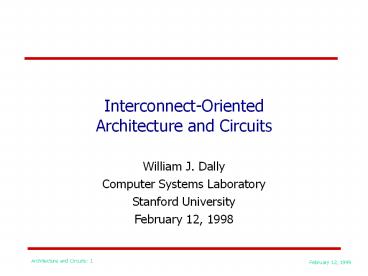Interconnect-Oriented Architecture and Circuits - PowerPoint PPT Presentation
Title:
Interconnect-Oriented Architecture and Circuits
Description:
Interconnect-Oriented Architecture and Circuits William J. Dally Computer Systems Laboratory Stanford University February 12, 1998 – PowerPoint PPT presentation
Number of Views:80
Avg rating:3.0/5.0
Title: Interconnect-Oriented Architecture and Circuits
1
Interconnect-OrientedArchitecture and Circuits
- William J. Dally
- Computer Systems Laboratory
- Stanford University
- February 12, 1998
2
On-chip wires
0.0mm
2.5mm
Minimum width wire in an 0.35mm process
5.0mm
7.5mm
10.0mm
3
On-chip wires are getting slower
x2 s x1 0.5x R2 R1/s2 4x C2 C1 1x tw2
R2C2y2 tw1/s2 4x tw2/tg2 tw1/(tg1s3) 8x v
0.5(tgRC)-1/2 (m/s) v2 v1s1/2 0.7x vtg
0.5(tg/RC)1/2 (m/gate) v2tg2 v1tg1s3/2 0.35x
y
y
x1
x2
tw RCy2
RCy2
RCy2
tg
tg
tg
4
Technology scaling makes communication the scarce
resource
1998
2008
0.35mm 64Mb DRAM 16 64b FP Proc 400MHz
0.10mm 4Gb DRAM 1K 64b FP Proc 2.5GHz
P
18mm 12,000 tracks 1 clock repeaters every 3mm
32mm 90,000 tracks 20 clocks repeaters every 0.4mm
5
Architecture Must Evolve to Fit the Landscape
20 Clocks
Global operations Low bandwidth High latency
High power
90,000 tracks
Local, parallel operations High bandwidth Low
latency Low power
6
Architecture Today Depends on Fast Global
Communication
- All instructions issued from single global
instruction unit - All data passes through global register file
- This wont work when global accesses cost 20
clocks of latency
I-Unit
Regs
7
Tomorrows Architectures must Exploit Locality
and Expose Communication
- Multiple elements (clusters) with
- local instruction dispatch
- local register files
- co-located with arithmetic elements
- Explicit communication between elements through a
switch or network - Fast synchronization between instruction units
Switch
8
Multi-ALU Processor Chip
9
Crafted-Cell Design
Area
Standard-Cell
Full-Custom
Crafted-Cell
80 Different Cells
7 Different Cells
17 Different Cells
1x
1.64x
5.25x
Performance
-Results courtesy of Andrew Chang
10
Interconnect repeaters with switching
- Need repeaters every 1mm or less
- Easy to insert switching
- zero-cost reconfiguration
- Cant afford decision time
- static routing
- fixed or regular pattern
- source routing
- on-demand
- requires arbitration and fanout
- Queuing and flow-control
- Pipelining control
1mm
1mm
Arb
LUT
11
(No Transcript)
12
Bandwidth Hierarchy
- Provide lots of bandwidth where its inexpensive
- short wires between ALUs
- Moderate bandwidth with intermediate cost
- local RAM associated with each ALU cluster
- Low bandwidth where its expensive
- Global RAM with long wires
- Very low bandwidth off chip
global30mm
medium4mm
local1mm
off chip
LocalRAM
ALU Cluster
Global on-chip RAM
LocalRAM
ALU Cluster
LocalRAM
ALU Cluster
LocalRAM
ALU Cluster
13
Bandwidth Hierarchy
- A key problem is to match the demands of an
application to the bandwidth available at each
level of the hierarchy - Casting applications in a streaming model exposes
much of the locality necessary to exploit the
hierarchy
LocalRAM
ALU Cluster
Global on-chip RAM
LocalRAM
ALU Cluster
LocalRAM
ALU Cluster
LocalRAM
ALU Cluster
14
Architecture Research Issues
- Processor architecture
- configuration of ALUs
- clustered vs distributed
- method for controlling ALUs
- distributed control, VLIW, SIMD
- communication aware instruction sets
- how to hide details while exposing communication
- Memory architecture
- methods for exploiting 2D spatial locality
- communication aware cache organizations
- Communication Architecture
- on-chip interconnection networks
- the use of repeaters with switching
- the use of hierarchy and selective fat wires
15
Circuit Challenges of Slow Interconnect
- The clock cycle is dominated by wire delay
- novel circuits to improve effective signal
velocity - Power is largely used to drive wires
- low-swing on-chip signaling methods
- reject rather than overpower noise
- Its difficult to distribute a global clock
- locally synchronous design methods
- fast synchronizers
- no wait for metastable decay
16
Overdrive gives 3x improvement in RC wire latency
17
Low-Swing Overdrive Signaling
1V Swing at Source
300mV Swing at Receiver
Recovered Signal
18
ConclusionExploit, Dont Fight, The Technology
- Interconnect is rapidly dominating the delay,
power, and area of ICs - Traditional architectures rely on global
communication - they are ill-suited for an interconnect-dominated
technology - Emerging architectures expose communication and
exploit locality - distributed register files and instruction
dispatch - bandwidth hierarchy
- Novel circuits can mitigate effects of slow wires
- overdrive, low-swing signaling, locally
synchronous design































